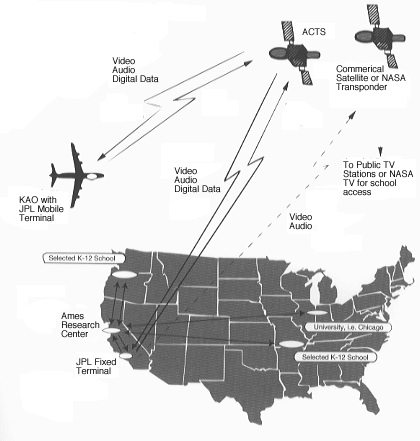

Now a new, steerable antenna, will permit full duplex, video, audio and data transmission between the ground and an aircraft flying at 3/4 of the speed of sound, at a bandwidth of at least 384 kilobits in each direction. The BAT antenna automatically tracks the ACTS satellite, and allows an aircraft to fly anywhere in the Western hemisphere. Live from the Stratosphere will be the first-ever use of this live two-way video capability for broadcast television.
ACTS uses video compression/decompression technologies, and the resulting signal will almost certainly not look like regular broadcast television-however the bandwidth should exceed that which was used from the South Pole (seen during last year's Live from Antarctica field trip.) We hope the excitement of live interaction with the KAO compensates for any video glitches.

The ACTS experiment also has applications to commercial aviation and government airborne services, such as Wildfire Research and Disaster Assessment. So when you travel aboard an airliner 5 years from now, engaging in an interactive videoconference with the ground, or watch a forest fire brought under control in record time, you'll be able to say that you participated in the first demonstration of a breakthrough technology.
The BAT antenna has been developed by NASA's Jet Propulsion Laboratory, Pasadena, California. The satellite itself is manages by the ACTS Experiments Office, NASA Lewis Research Center.
While the technology seems complex, the aim of the ACTS experiments is profoundly human: to connect students to a inspiring educational experience previously impossible. Scientist and author Arthur C. Clarke wrote that at first any sufficiently advanced technology seems magical. To paraphrase John F. Kennedy's comment about the race to the Moon, NASA and public television choose to do things like this "...not because they are easy, but because they are hard." We hope Live from the Stratosphere gives you, as teachers, a unique tool with which to excite your students about science and technology.
This page was created by Tobin A. Snell and Joshua Parker, seniors at Palo Alto High School, California.
![]()